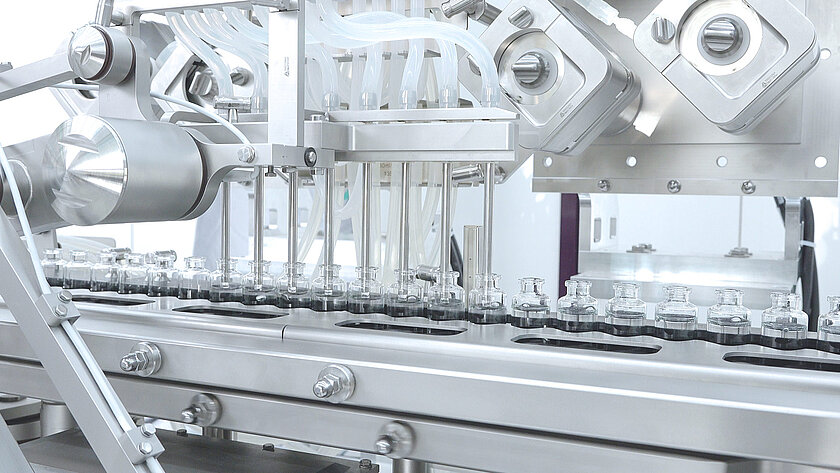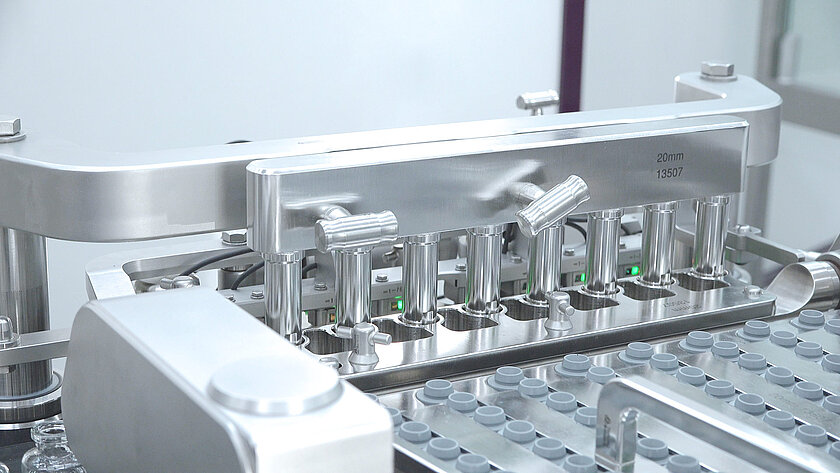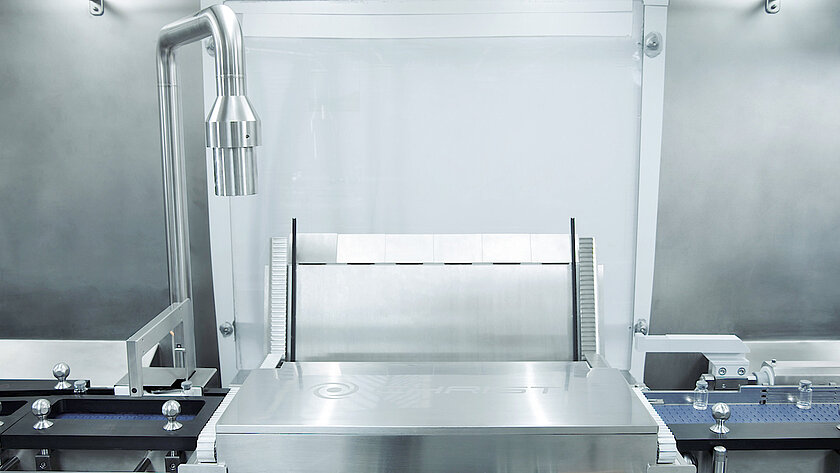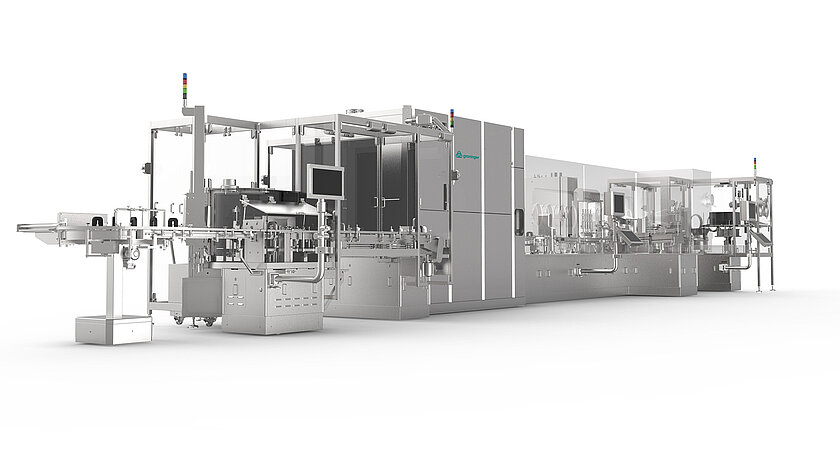
Vial filling machine: Washing, sterilizing, filling and closing
An essential part of our aseptic filling machine portfolio are our vial filling machines. These fillers are equally suitable for small and large batch filling, for development and for clinical studies. Whether you operate commercial production or supply vaccination campaigns, our lines make it possible to cover all output ranges from 50 to 600 units per minute (3,000 to 36,000 per hour) with maximum flexibility.
Our innovative automatic vial filling equipment is developed to be used in sterile areas or clean rooms, in compliance with the cGMP requirements. The areas of application inside the pharmaceutical industry are diverse: vaccines and biologics can be filled as well as cell and gene therapies, regardless of whether they are single or multi-dose products.
The cutting-edge technology of our groninger vial fillers enable the processing of a large number of different pharmaceuticals: with the quickconnect system, for example, format changeover can be carried out on the entire line without having to use any tools. If needed, it can also be done with an electronically guided installation aid.
Depending on requirements, steps such as sterilization, freeze-drying and external cleaning can be integrated. This means that aseptic or toxic processing on groninger lines up to a level of OEB5 or BSL2 is also possible.

Steps of our vial filling and stoppering machines
Washing
For aseptic processing, the glass containers are fed into the machine via a buffer to be washed and then sterilized.
In recent years, groninger has optimized the washing process through extensive tests and CFD studies and established it as a standard. Consequently, vials are efficiently cleaned on the inside and outside on our lines. After the up to 3-log reducing cleaning, the containers are dried and transported to the subsequent step, generally being sterilization.

Sterilizing
Our sterile tunnel is designed to carry out gentle yet effective sterilization to a large extent; at the same time, the corresponding line areas are very easily accessible because they can be accessed from both sides, allowing it to be cleaned without any problems.
The new type of sterile tunnel developed by groninger works with gentle heating of the objects in the entry area to the sterilization area. The object itself is subject to only a small temperature difference, which means that overkill in the sterile process can be avoided. High-end sterile filters guarantee the highest quality.

Filling
Discover the unparalleled versatility of groninger automatic vial filling machines. From life-saving vaccines to delicate cosmetic medicines, our innovative technology ensures the safe and precise processing of a wide range of liquid formulations.
Our vial fillers are designed to accommodate diverse products, spanning from thin to viscous consistencies. Whether your formulation is water-like, WFI-based, or a quickly settling suspension, our machines deliver consistent results with uncompromising accuracy.
With expertise spanning various industries including pharmaceuticals, biopharmaceuticals, veterinary products, and cosmetics, we understand the unique requirements of each product category. From orphan drugs to biologics and beyond, our vial fillers provide unmatched versatility and reliability.
Experience peace of mind knowing that your valuable pharmaceuticals are in capable hands. Trust groninger automatic vial filling machines for efficient, safe, and precise liquid filling solutions tailored to your specific needs.
The supply of pre-sterilized packaging containers may take place via an upstream sterile tunnel or via a ready-to-use supply. For quality assurance, the containers can be inspected in advance by cameras and subsequently sorted out should there by any defects.
Other integrity tests such as PUPSIT (Pre-Use-Post-Sterilization Integrity Test) can also be performed to meet the latest Annex 1 requirements. Clean-in-place or sterilization-in-place (CIP/SIP) is also possible on groninger lines.
When it comes to aseptic liquid filling, groninger relies on proven filling technologies, e.g.,
- rotary piston pump (RKP),
- peristaltic pump (PP) and
- time pressure filling systems (TPF).
Of course, product-relevant tasks such as product mixing, recirculation or product filtration can be carried out on the filling path. To avoid cross-contamination, the fill path can be set up as a single-use fill path.
A 100% In-Process-Control (IPC) is now standard for groninger and is increasingly replacing the Statistical In-Process-Control (IPC). This also includes weighing the objects before and after filling to be able to check the filled content precisely. At the same time, groninger smartfill technology minimizes product loss during filling, both of which save you work, material and consequently money.

Closing
We also ensure highest quality when it comes to closing objects, particularly, making sure that no unnecessary particles get into the pharmaceutical product, as well as great flexibility and process reliability. groninger lines process a large number of different rubber stoppers, including the relatively young push-fit vial closure systems (e.g. RayDyLyo® or DAIKYO PLASCAP®).
To enable maximum flexibility, we limit the number of closure size-dependent sorting and feeding formats. Omitting vacuum-controlled lines makes cleaning, in particular, much easier. However, our stoppering systems are also easy to maintain and look after due to their sophisticated ergonomics and the good accessibility of all individual parts.
For the processing of sensitive products, the "headspace" can be gassed in a container to reduce the residual oxygen level to less than 1%.
To further minimize product rejects, our vial filling machines can be designed with a re-stoppering function, allowing to the loss of a stopper to be compensated by repositioning it.

Freeze drying
Freeze drying can extend the shelf life of many liquid medicines. The active ingredients remain intact and retain their effectiveness.
We have already integrated freeze drying in numerous lines. How exactly this process works, how it is mechanically and electrically integrated, is something we explain in detail for each project based on the specific requirements.
With a combined liquid and lyo line, a connection to the freeze dryer can be a great solution in a very space-saving manner. At the same time, it reduces the complexity of the isolator, which facilitates the changeover from the freeze-drying process to a liquid filling and closing process and reduces set-up times.

Sealing
For liquid pharmaceuticals, vials can be sealed within one line or immediately afterwards on a separate, compact machine. Our capping process easily meets the requirements of EU GMP Annex 1 – this is a groninger standard.
groninger relies on the patented, very proven and low-particle single-disc sealing principle. That means, that our vial filling and capping machines closed the containers with an adjustable and non-slip closing disc. This is done in various performance classes from 10 to 600 objects per minute with extreme reliability. An optional extraction makes it possible to further reduce even the already low number of particles.
Compared to other solutions with several sealing discs, the line can be changed over much more quickly, and faults can be detected immediately; overall, it reduces the risk significantly. Vials with poorly-fitting stoppers can be rejected prior to the sealing process.

External cleaning
When processing toxic products, operator protection is a top priority in addition to pure product protection. That's why we attach great importance to the fact that vials filled with these drugs – in liquid form or as a powder after freeze-drying – are reliably cleaned on the outside.
With our extensive portfolio in the field of exterior cleaning, we are able to offer the right system for your product as well.

Coding
It must be able to track or sterilize individually produced products. For this reason, printing is important to code the individual object; it is the only way to track the product life cycle.
On the groninger lines, coding is not an independent process, but rather a solution integrated into the lines. Individual objects can usually be printed using an inkjet or engraved using a laser. Inkjet printing can also use UV ink, which only certain light sources make it visible.
The information required for coding is delivered securely and reliably to the printer and the inspection system.
Tray loading
At the end of the entire run throug, the objects are collected in a tray for storage. groninger offers easy-to-use solutions for storing the objects piece by piece, either in a tray system or very gently by pick & place.
To make the system easier to use, we introduced a tiltable drawer system; this allows for extremely user-friendly closing of the plastic or metal trays.

First-class technology and innovations for processing vials in bulk
Deciding for groninger – a decision for the number one, groninger is one of the world’s leading suppliers in bulk processing. Higher productivity, shorter set-up times and optimal maintenance are the keywords. The permanent availability of the line is a requirement that we as a manufacturer are able to fulfill. We accompany the machines we build throughout their entire life cycle.

Filling line with performance up to 60 objects per minute
- Processing in bulk or in trays
-
All common filling systems possible
-
Standard gassing functions
-
smartfill for minimal product loss
-
quickconnect for quick changeover of other formats
-
100% In-Process-Control (IPC)
-
Design for isolators, open and closed RABS systems
Filling line with performance of 60 - 200 objects per minute
- Processing in bulk or in trays
- All common filling systems possible
- Standard gassing functions
- smartfill for minimal product loss
- quickconnect for quick changeover of other formats
- 100% In-Process-Control (IPC)
- Design for isolators, open and closed RABS systems
Filling line with performance of 200 - 400 objects per minute
- Processing in bulk or in trays
- All common filling systems possible
- Standard gassing functions
- smartfill for minimal product loss
- quickconnect for quick changeover of other formats
- 100% In-Process-Control (IPC)
- Design for isolators, open and closed RABS systems
Filling line with performance of 400 - 600 objects per minute
- Processing in bulk or in trays
- All common filling systems possible
- Standard gassing functions
- smartfill for minimal product loss
- Statistical In-Process-Control (IPC)
- Version for isolators, open and closed RABS systems
Our selected comprehensive solutions for filling and closing vials in bulk
Our integral line concepts save you long planning phases, because we are able to provide you with a comprehensive solution for many demands.
This is the core of our ready engineered philosophy: Instead of lengthy planning and construction phases, you will get a well thought-out line concept that gives you maximum flexibility and plenty of design freedom. To this end, we have incorporated our know-how on processes and lines into the concepts, which we have gained over decades jointly with our partners.




